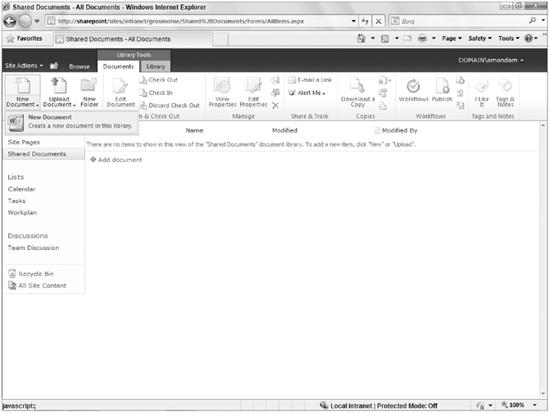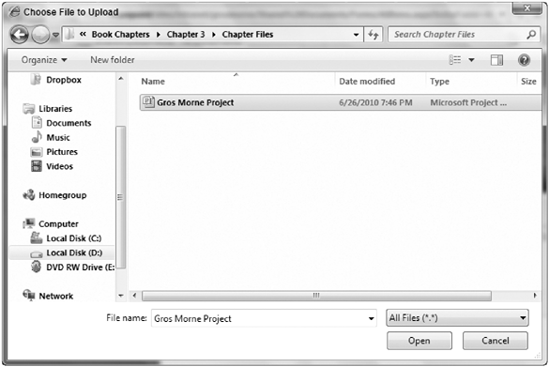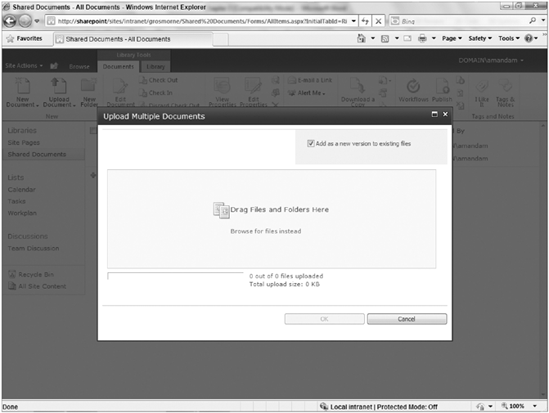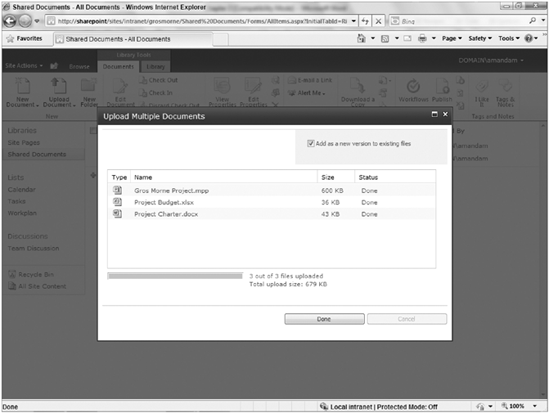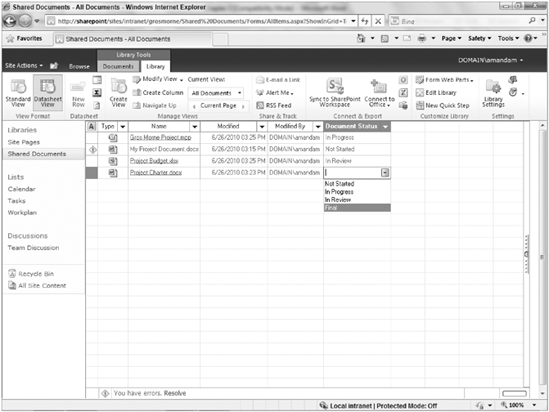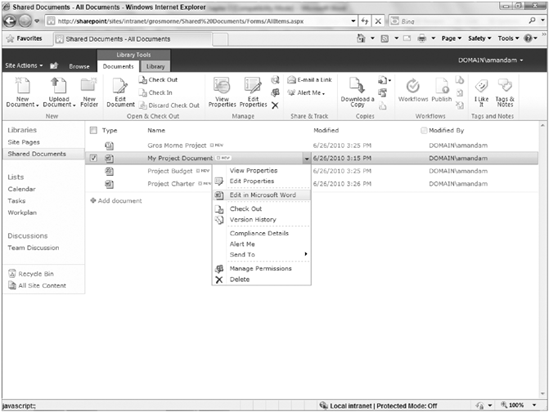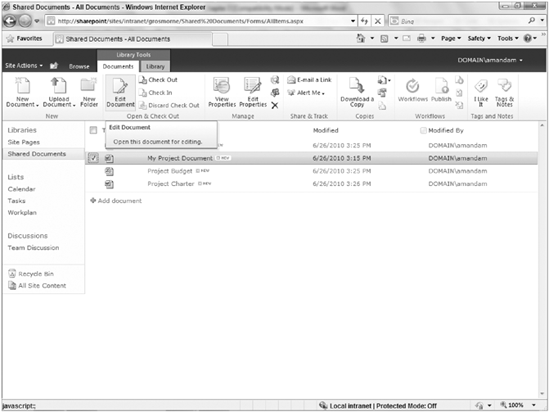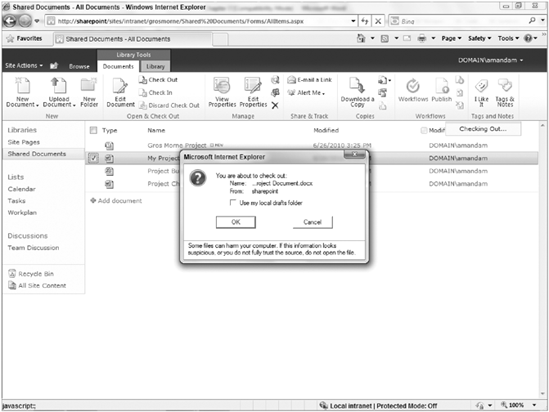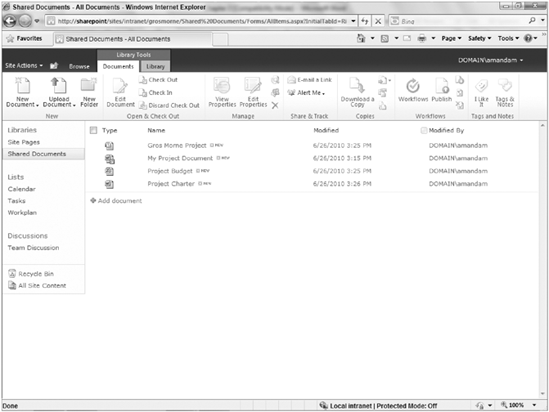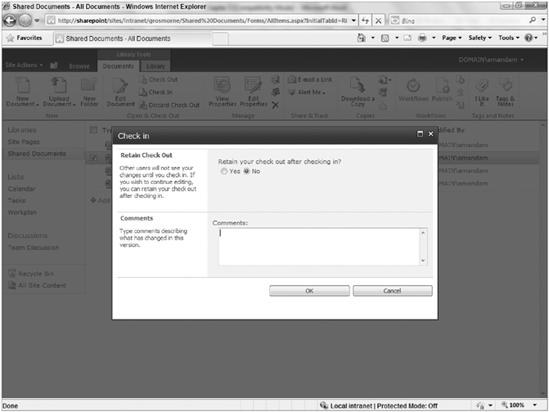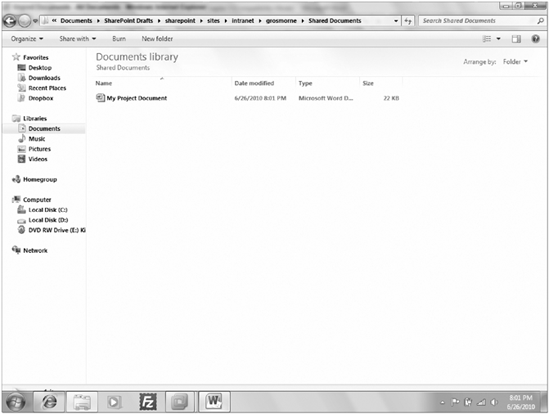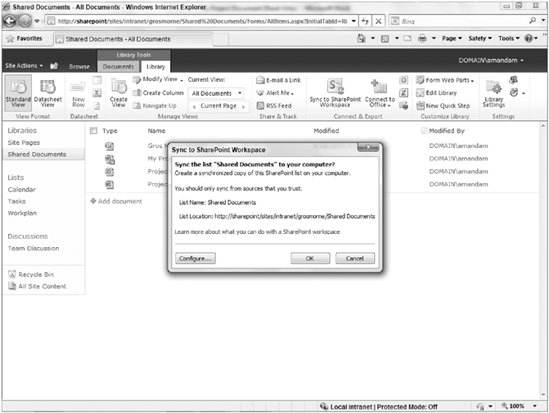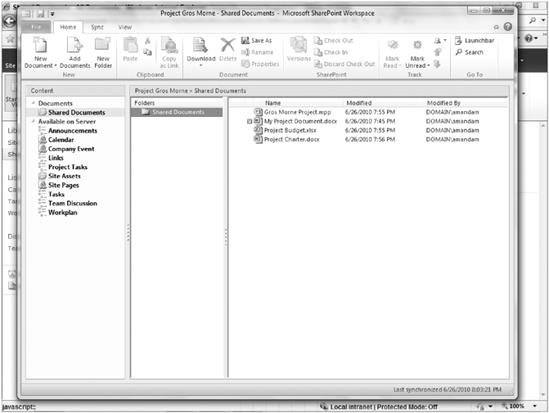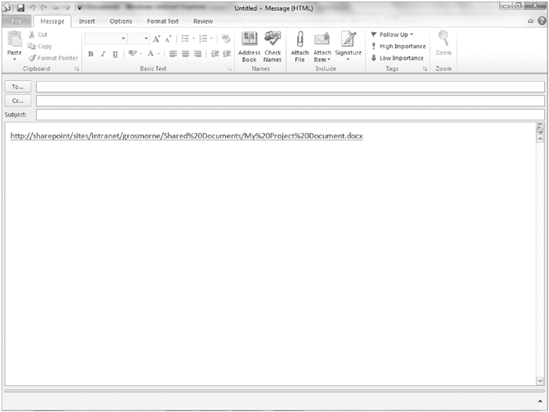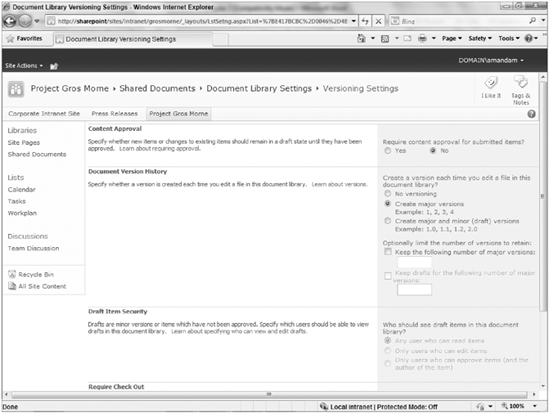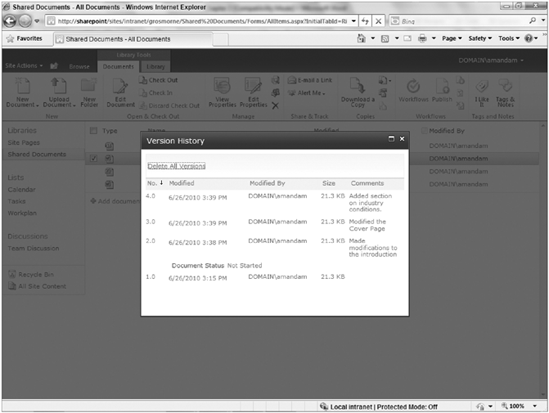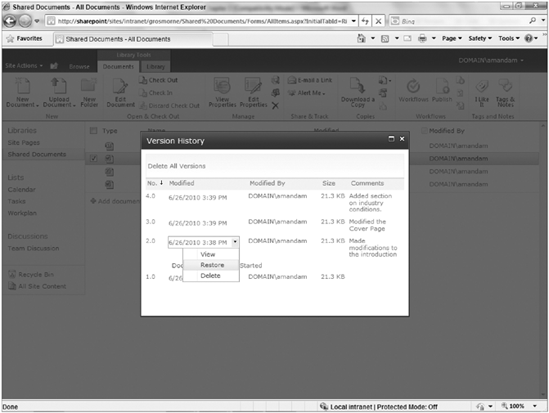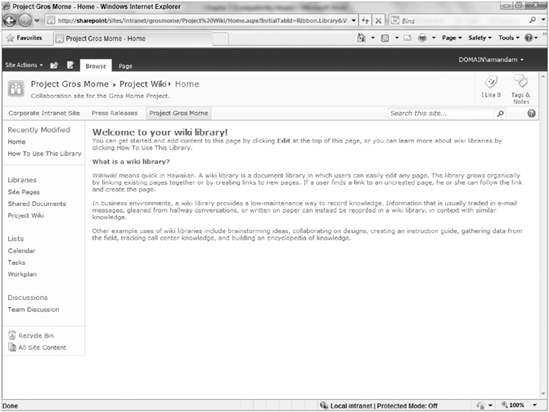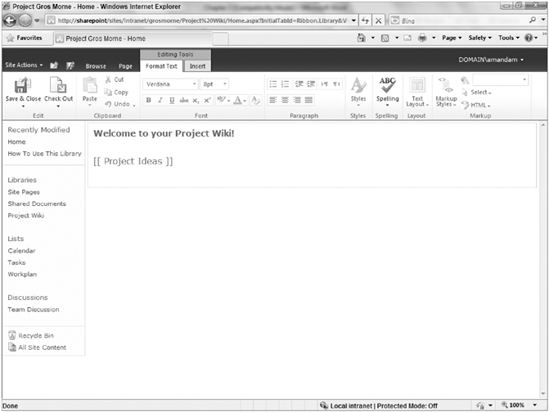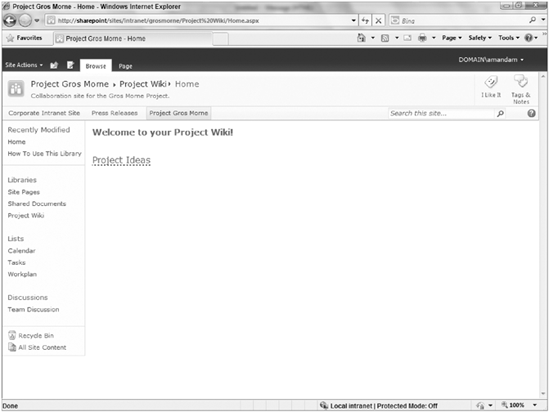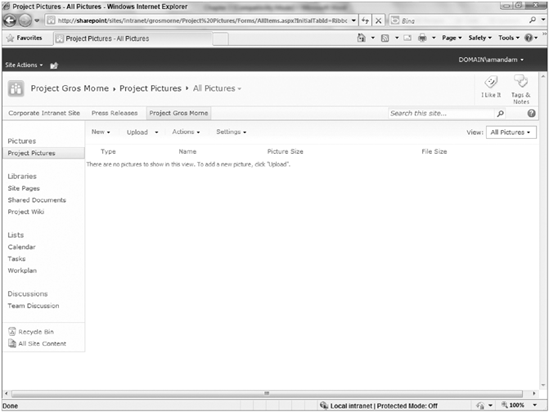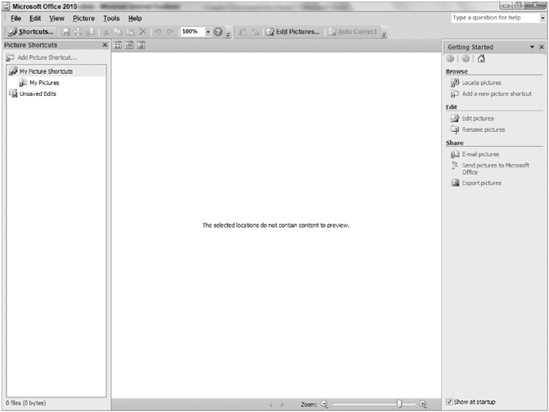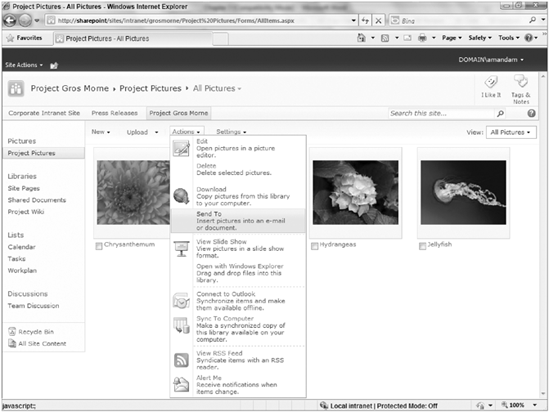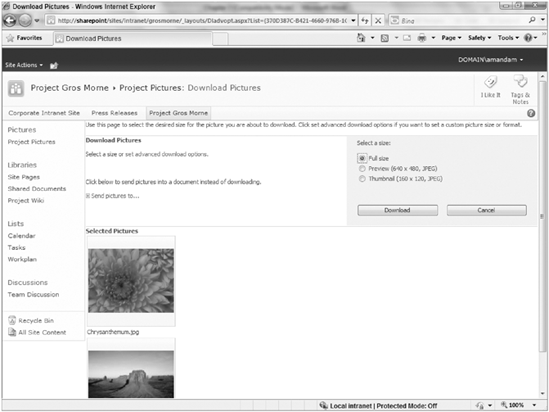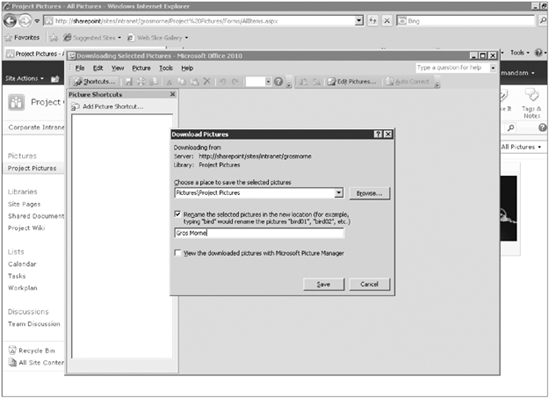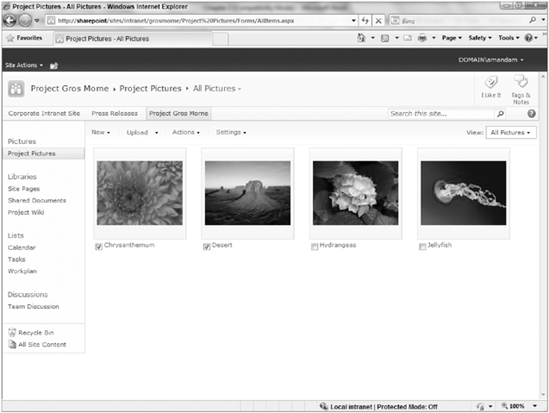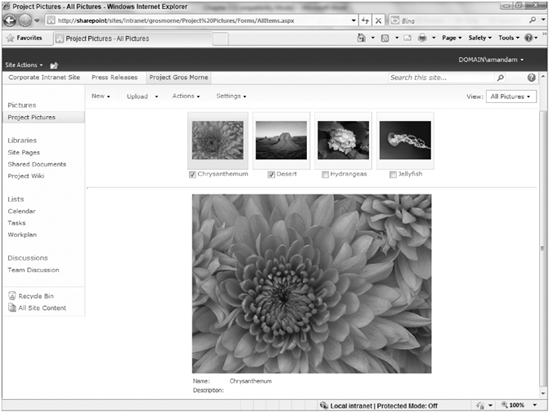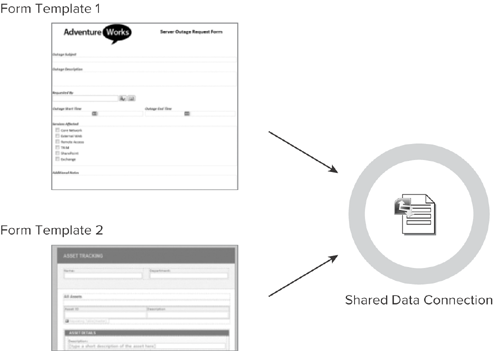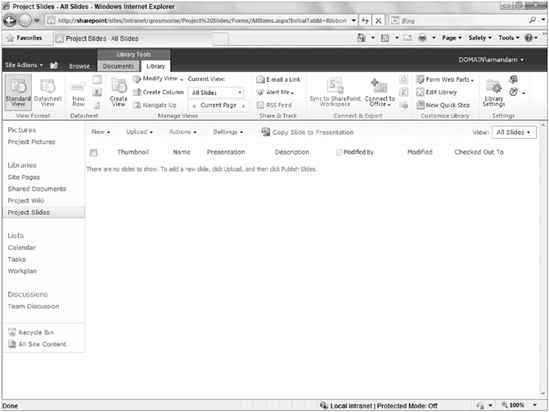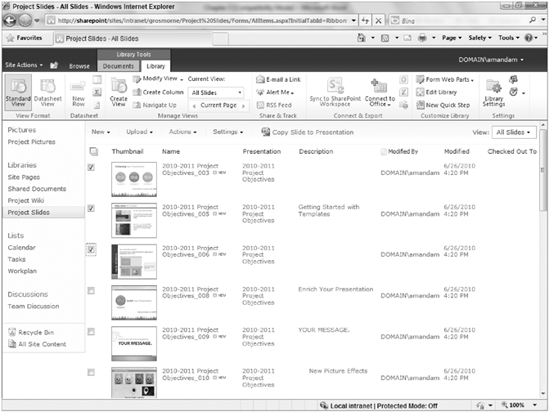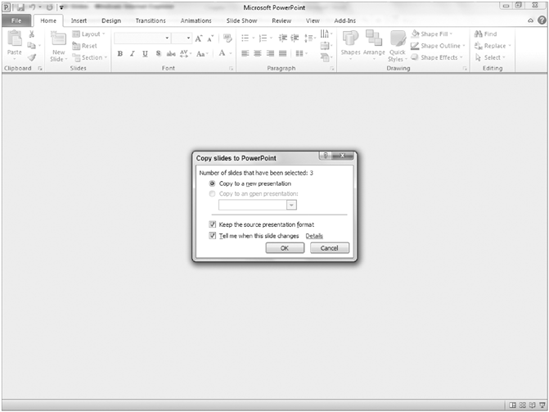WHAT YOU WILL LEARN IN THIS CHAPTER:
The key activities related to a document library such as the creation, uploading, and updating of files
The core functionality available related to tracking unique versions of files
Features available within the various library templates in SharePoint 2010
In this chapter, you discover the magic behind document collaboration: the document library. Document libraries allow you to create, store, manage, and collaborate on documents. SharePoint has a variety of library templates, each designed to allow maximum efficiency when you work with particular types of documents. This chapter discusses the major elements of a document library and steps you through some of the different library templates and how you can use them to manage the documents crucial to business operations.
In Chapter 4, you will learn how to configure the properties and features of a document library to fit your business needs. This chapter focuses on interacting with document libraries that have been previously created or configured.
If you want to, you can think of a document library as a Windows file folder but better. Like folders, libraries act as document storage, but they also store the document's metadata or version history (more about these a little later), which folders do not. Also, Windows file folders lend themselves to user personalization in that they may stay on a user's drive or be labeled differently from another user's folder, which leads to inefficiency. You don't encounter this in libraries, which act as central stores, shared across an organization or team. SharePoint also offers collaboration features that go well beyond the traditional file-sharing techniques that you may have used in the past. Also, because SharePoint stores lists and libraries in a database rather than the file system, it is arguably more secure, more efficient, and enables more sophisticated document workflow and content management scenarios. Users are only able to see files that they have been granted access to which only exposes relevant files to their role and improves the ease by which information can be found.
Note
While we often refer to the storage of documents in SharePoint libraries, it is important to know that you can store a variety of file types, including presentations, images, forms, and spreadsheets. You can store virtually any file type in a SharePoint library as long as the file type has not been added to the Blocked File Types listing.
Metadata information: Document libraries have metadata columns for attaching information, such as document owner or status, to the document and, thus, tailoring it to your corporate practices. Metadata is useful for running searches on documents, which you learn more about in Chapter 17. Users with appropriate permissions can quickly and easily create extra metadata columns to describe the contents of a library. In fact, SharePoint document libraries offer many of the same features of lists that you explored in Chapter 2, such as rows, columns, and views.
Document protection: Documents in libraries are protected by a check-in and check-out feature, which ensures that only one user at a time can edit a document. Later in this chapter, you learn about the various methods available for working with documents in this manner.
Document history: Libraries keep a document audit trail, known as version history. This feature allows you to easily and quickly revert to a previously saved version of the document, directly from the browser. The version history feature will track changes that are made to the document's content as well as its metadata. Depending on which site template you are using, this feature may need to be enabled prior to its availability for use. The process for doing so is described later in this chapter.
Major and minor versions: While both lists and libraries support versioning of information, document libraries support minor and major versions. Major versions are published files that are accessible to all site users, whereas the minor versions are files in a draft state that typically only a document's author or members of an approver's group can access.
On the surface, a document library view page, shown in Figure 3-1, looks very similar to a list with a few additions, including:
Upload button: Located on the Ribbon, this button supports the uploading of single or multiple files to the library.
Open with Explorer button: Located on theRibbon, clicking this button will open the library in a Windows Explorer type folder. Using this option, you can drag and drop files into folders, delete multiple files at once, and create new folders the same way you would when interacting with a standard Windows file folder. This feature requires the use of Internet Explorer 7.0 or later.
Copies: Unique to the document library, this section of buttons provides you with the ability to interact with the document by downloading a copy of it, sending it to another location, creating a document workspace, or managing copies of the file within the system. We will cover these actions later in this chapter.
Both employees and organizations benefit from SharePoint libraries. Organizations commonly roll out SharePoint to help ensure that documents are stored in a secure system where access, versioning, templates, columns, and content are controlled. From a user's perspective, creating and managing documents in a library is a simple process. You start by creating a document that is based on the latest version of a template. You can also easily upload single or multiple files to a location that is shared by other members of your team.
This section has a series of Try It Outs that walk you through many of the actions available within document libraries. Before you start, however, you need to understand the various document templates, shown in the following table, that can be created by clicking the New button within a document library. The obvious purpose of these templates is to start with blank document or files; however, you can also create custom templates that help your company to maintain a consistent look and feel for common document types. For example, you can have a sales proposal presentation template that contains important elements, such as your company's name, logo, and website information on every slide. Associating this template with the sales team document library allows an account manager to launch a presentation containing these elements with a single click.
How It Works
When you upload in step 4, you are presented with a standard file-open dialog box from which you can navigate to and select the file. After selecting your file and clicking OK, your document is transferred to the document library and, if applicable, you are prompted to enter any metadata that your document library requires. When uploading the file, you may have noticed the checkbox in Figure 3-2 to add the file as a new version to existing files. By selecting this box, any files that exist in the library that contain the same file name will be overwritten by the newly uploaded file. If version history is enabled in the library, the previous version of the file will be accessible through the version history.
How It Works
In this example, you temporarily changed a standard document library view to a datasheet view. This allows updates to be made to the metadata associated with all documents within your document library. Editing a datasheet view is very similar to completing information within a spreadsheet application and is, therefore, ideal for occasions where a team member must update metadata in bulk. While you can create views that are always in datasheet mode, you can edit any standard list view in datasheet mode as shown here.
You now know how to create documents within your libraries as well as how to upload documents and update the metadata associated with them. Next is to understand how to update documents that are already in a library.
Your document's lifecycle will probably require you to perform updates and edits over time. You can quickly open and edit any document inside its document library via either of the following methods:
Via the contextual menu: Hover over an item in a library to expose a contextual menu and then select the down arrow. Select Edit in Microsoft Word (or other application if applicable) from the list of menu options, as shown in Figure 3-7. You have several other options, such as Edit Properties, which edits the metadata, or View Properties, where you can view additional information associated with the document.
Select an item in a document library and click the Edit Document item from the Ribbon as shown in Figure 3-8. The associated application opens so you can begin editing.
Obviously, the collaborating often requires that people work on the same document; however, this can lead to version conflict. For example, if you work on a document but leave the office for an extended period of time, another user can make changes to your document that conflict with your version or upload an older version of the document that could lead to confusion or lost work. When you resume your work, you definitely will notice changes but not necessarily know why or how the document was changed.
To minimize frustration, instead of directly editing the document via the contextual menu or from the document library, you can select the Check In/Check Out options beforehand. Checking out a document locks it so that others can view the last published version but cannot edit it or upload a version of the document, until you check the document back in.
The next three Try It Outs cover how to check out and check in a document, either from the SharePoint library or from an Office application, such as Word. The Check In/Check Out feature has the added benefit of allowing you to work offline while the file is in the checked-out stage. This means you can perform changes away from the office and these changes will be placed in the library when you check the document back in. In the last Try It Out, you learn how to send your colleagues notification so that they're aware of the changes you've made to a document.
Note
SharePoint's Check In/Check Out feature is controlled as part of library versioning. To configure and customize the settings for this feature, see Chapter 4.
How It Works
When you check a document out from a library, it becomes locked and reserved to you for editing. Other members of your team may still open the file; however, they will be unable to make changes to it. When other team members view the document, they will not see the changes you are making until the document has been checked into the library again.
How It Works
Once a document library has been synchronized with SharePoint Workspace, you will have the ability to interact and edit the documents as if you were in the browser. Activities such as Checking Out, Checking In and Editing a Document are available within the SharePoint Workspace Ribbon. In addition, new files can be created and added using this application. You may make these changes remotely while not connected to the network and changes will be automatically synchronized back to the SharePoint document library the next time you launch the application while connected to the network.
You may notice in Figure 3-15, that other lists and libraries from your site are listed in the side panel. You may also right-click on each of these to open the lists or libraries from the site within SharePoint Workspace or the browser.
Imagine working all night on a document and saving your changes to your team's collaborative location, only to have a team member overwrite your document with an older version of the document. For a collaborative team, multiple versions of a single document or overwritten files can translate into lost work and frustration. That's why most organizations implement a document audit trail, which helps users understand when changes were made and why. SharePoint's Version History option allows you to view this trail as well as restore previous versions if you catch errors or omissions in the active version. If versions after a certain date are in doubt, you can restore the document to point where you know the information is accurate and relevant. In addition, having a version history can help organizations identify exactly what a document looked like at an exact point in time.
In the upcoming exercises, you learn how to enable version history tracking on a library and how to view the version history related to a document and optionally restore a previous version of a document as the active version.
Note
In Chapter 4, you will learn how you can customize version history settings of a document library.
So far this chapter has generically referred to libraries as document libraries. However, SharePoint actually has various library types, just as it has multiple varieties of lists. Libraries are generally defined by what you place in them. Once you create your library from the appropriate template, you can have others access the library and add content to it. Chapter 4 shows how to create and customize new lists and libraries; however, in this section, you learn about the features and functions of each so that you select the proper library for your team. The SharePoint library templates are described in the following list:
Document libraries: This library stores the majority of documents and files in a SharePoint site and is the most common type of document library created.
Form libraries: You use this template to create libraries that store InfoPath form data and templates. You may use this to store submitted forms, such as purchase requests or status reports created using the Microsoft InfoPath client application or Forms Services.
We will review this library and InfoPath in greater detail in Chapter 12.
Wiki page libraries: You use this kind of library for wiki pages, which are collaborative web pages that teams use to share information in a highly interactive and less structured environment. This is perfect for storing a knowledge base or FAQ section.
Picture libraries: This library is for sharing photos and images in a collaborative environment. This library uses columns and properties to define images, and has special thumbnail views of the stored files. It's ideal for storing team member photos or your company's logos.
Asset libraries: This library is for sharing rich media assets such as images, audio, and video. When an asset library is created, it is preconfigured with metadata and settings required for sharing rich media files.
Slide libraries: You use this library to share PowerPoint presentation slides. Users can upload slides to the library so that other users can browse for slides and use them in new presentations. This template works well for teams that are responsible for creating presentations and want a central gallery from which to select the latest slides and information.
Data connection libraries: These libraries store trusted data connection information that link SharePoint with documents created using InfoPath or Excel. We will explore this library type further in Chapter 12 and 16.
Report library: This specialized template creates libraries that store spreadsheets and dashboards as part of the business intelligence capabilities of SharePoint Server 2010. You would use this template to create a location for reporting that would allow business managers to publish spreadsheets to others that could be viewed via the browser and that would hide any protected information from users. This type of library will be discussed in Chapter 16 along with business intelligence, because this template type is specific to that feature of SharePoint.
Document libraries can store just about any kind of file and are at the center of SharePoint's file-sharing and collaboration features. The anatomy of a document library is very similar to a list and includes the following elements:
File Item: From Chapter 2, you know that the primary element of a list is an item. Likewise, the primary element of a document library is a file. Most organizations collaborate using Microsoft Office documents (Word, Excel, and PowerPoint) or other common formats, such as PDF, HTML, or JPEG. Document libraries support just about any file type, assuming that an administrator has not explicitly blocked it.
Columns: The column types available for lists are also available for document libraries. Depending on what template you select, certain columns may already be created for you. Most libraries share a common set of columns; however, special templates, such as the image library and assets library, contain additional columns such as image size and copyright. You can create additional columns at any time if you have the appropriate rights to the site.
Note
You can find out how to add new columns to a library in Chapter 4.
Views: Similar to lists, document libraries display their items in views. The default view for a document library is the All Documents view, which shows all documents stored within the library in groups of 30 in the following columns:
Document Type: Displays an icon representing the document's file type.
Name: The file name of the document.
Modified: The date and time the document was last modified.
Modified By: The name of the user that last modified the document linked directly to their user profile or MySite.
Note
Users with the appropriate rights can create custom views at any time. This activity will be explored in Chapter 4.
Form libraries are special types of libraries that store InfoPath forms. Microsoft InfoPath is an application that allows you to collect and share data via highly customizable electronic forms. You can use this application to create form templates that reflect their data collection needs without requiring code or special development skills. The application makes it very easy for business users to craft an electronic form that suits their needs by dragging and dropping form elements onto a page. Users can complete InfoPath forms using either the InfoPath application or via the browser using the Enterprise Edition of SharePoint Server 2010.
You can promote data stored in InfoPath forms to the library so that you display the data in views. This gives you more advanced reporting options on the data contained in multiple forms. You might find it advantageous, for example, to create an InfoPath form to collect data from your portal users instead of using standard list functionality because with InfoPath, you can do the following:
Connect to external data sources such as databases, SharePoint lists, or web services to either retrieve or submit data
Customize the interface in ways not possible using standard lists via the browser
Use code to extend forms to provide additional functionality and enhancements related to more complex data calculations or routing
We will explore InfoPath forms and the libraries they are stored in in Chapter 12.
With wikis, a very popular collaborative tool for group sharing and editing content, you can add, edit, or remove web page content in an open and informal manner without following a restrictive editing or approval process. Users can edit wikis using SharePoint's built-in content editor without knowing a special language. Because of the informality and lack of restriction, wiki pages are a more inviting way for team members to record their experiences and goals.
SharePoint has an option for creating either an entire site to act as a wiki or just a wiki document library within a site:
A wiki site: Useful for a technical support team's knowledge base or a training department's tips and tricks documentation. Any collaborative site in SharePoint can be transitioned into a wiki site using a special feature that transforms the main page of the site into a wiki page. We will review wiki sites further in Chapter 8.
A wiki document library: Provides collaboration tool for planning and sharing ideas around specific operational events. This is illustrated in the next Try It Out.
The next two Try It Outs show how to create a wiki document library as well as how to create a new wiki page.
Although document libraries can store just about any file type, in some cases it's better to have a library that caters to a specific file format. Such is the case with the Picture Library template, which efficiently displays pictures and images because it includes a thumbnail preview feature. This is an invaluable feature for locating the correct image in a large collection of images.
This next series of Try It Outs demonstrates the features that make the Picture library unique. In the first Try It Out, you create a picture library using the Picture Library template. In the second Try It Out, you upload pictures into the newly created library to simulate a person sharing images with his or her team. In doing so, you will see first-hand the unique commands it offers in its menu. These commands are listed in the following table.
MENU ITEM | DESCRIPTION |
|---|---|
Edits the selected images in a compatible editing tool | |
Delete | Deletes the selected images from the picture library |
Download | Downloads all selected images to the user's computer |
Inserts pictures into an email or document | |
Opens a new window displaying a slide show of images within library |
In the third Try It Out, you act as someone taking images from the library. You download files and see the picture library's unique options. When you download a file, you can change the size of your image. You can also change its format to one of the following:
You can also apply one of three subviews of a primary view. These subviews are:
Details: This updates metadata associated with a file stored in a picture library.
Thumbnails: You can use this to preview images in a thumbnail type view.
Filmstrip: This view previews a larger version of the image within the browser window.
Microsoft Office applications, such as Excel and InfoPath, have great built-in support for data connectivity to external sources such as databases, web services, and even SharePoint sites. Traditionally, this meant that you managed data connections on an individual usage basis. Therefore, every time you connected to the data source, you needed to define the connection within the file or settings. This often made it very cumbersome to embed external data into files and subsequently make changes to the data source or file. For example, it might seem logical to use a SharePoint customer list in your InfoPath forms any time that you wanted to display a listing of customer names. To do this, however, you would need to create a data connection within your form template each time you wanted to include customer information.
If you later decided to move your SharePoint list to another location or add new columns, in order to have the changes updated within your InfoPath form, you would have to go back into each form template and update the settings.
Data connection libraries solve the cumbersome connection dilemma of how to deal with past versions by allowing you to create data connection files. These Universal Data Connection (UDC) files contain all the connection settings applicable to the data source and usage scenario. Therefore, instead of specifying the connection settings in each of your form templates, you save the connection settings as a file and have your form templates point directly to this file, as shown in Figure 3-32. When you do this, making changes to a single file updates multiple templates.
Note
In Chapters 12 and 16, you work in greater detail with data connections. These chapters have specific examples of how beneficial data connection files can be and how you can store them centrally in a data connection library.
Because PowerPoint presentations are a common way for members of an organization to communicate, companies generally produce, deliver, and store presentations in large quantities. Unfortunately, the sheer quantity can cause the following issues:
Duplicated work: Because individuals are seldom aware of a fellow colleague's work, there is very little reuse of information.
Outdated material: Duplicated material across many locations means that an individual is more likely to grab an outdated presentation or present the wrong version of a presentation. This can lead to miscommunication of objectives or performance.
Inconsistent presentation: Depending who creates a presentation and what their interpretation of the content is, an organization may encounter company-wide inconsistencies in how data is presented to customers, partners, and other important stakeholders.
For these reasons, many organizations try to standardize how information is presented. SharePoint offers a unique method for consolidating presentation information that encourages users to share slide content.
The slide library template in SharePoint allows authors to upload slides to a library where other team members can view them. The following Try It Outs show you how to address these issues and, by doing so, help reduce duplicate efforts while protecting the quality and integrity of your organization's presentations. First, you learn how to upload a presentation to a slide library. You next create a new presentation in the library, and then update a presentation to incorporate corrections to a source slide.
This chapter discussed document collaboration in a team environment and then detailed the benefits and pitfalls arising from managing a single document with multiple editors. Things to remember about this chapter:
SharePoint's library feature enables you to create, store, and manage your documents from a central location.
Document libraries let you track a variety of different types of information. It is the most common type of SharePoint library.
SharePoint also offers you libraries that are for a specific type of file or information and has templates to create these libraries, including InfoPath form data, images and pictures, Excel spreadsheets for browser-based reporting and dashboards, data connection files, and media and presentation slides.
Throughout this chapter, you looked at the ways that a user can interact with document libraries and the content within them. In Chapter 4, you will take a deeper look at customizing libraries along with lists to suit specific needs your organization might have.

